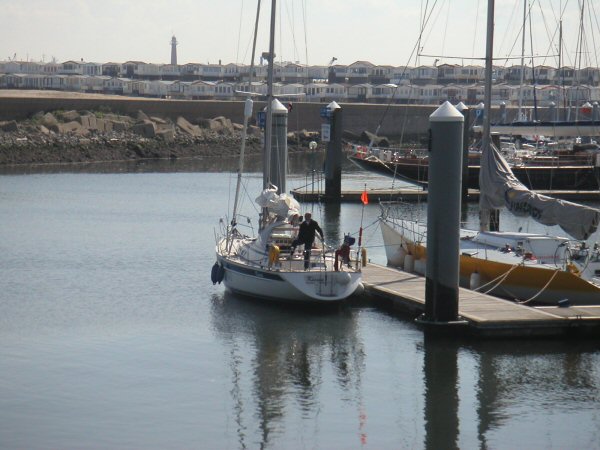
The North Sea
For most people, the first hurdle in getting to the Baltic is the North Sea. Renowned for its short, sharp chop and masses of traffic, its a big deal for the first timer.
At first glance, there are a myriad number of potential departure and arrival ports, however these are limited slightly by the need to keep out of the way of the various precautionary areas, and also by the numerous sandbanks which fringe both coasts.
The Coastal Route
The 'Easy Route' is to hop from Dover across the busy Channel TSS to Calais (22 Nm) or to Dunkerque. It is then an easy series of coastal hops to Nieuwpoort or Oostende, Zeebrugge,and finally Vlissingen. If leaving from Ramsgate, both the TSS and the Nieuwpoort bank (sandbank) makes Oostende a better destination.
The coastal route between needs to be followed closely as it can be tricky, but it is well bouyed. All the listed ports have facilities for yachts, however Calais is accessed via a lock which only opens a couple of times per tide, so Dunkerque, with its easily accessible marinas, is a better bet. Nieuwpoort always has space in its three huge marinas, but the town is a 20 minute walk away. Oostende has a marina in the center of town (Mercator) which is excellent for long stays, but it is accessed via a lengthy lock and gets very busy in season. There are two other marinas. The North Sea YC gets very busy, and the Royal YC of Oostende is a decent walk from the town. Observing the traffic signals on the harbour entrance is a must.
Zeebruge has a good marina right at the back of the industrial port with some shops and resturants nearby, however the harbour walls can cause some very nasty seas with wind over the ebb.
Vlissingen is the entry point for the Dutch inland waterways, and there is a huge marina at Breskens on the opposite bank if you dont want to go through the lock immediately. Both the traffic and the tides need to be watched in the Westerschelde.
Harwich to Ijmuiden
The shortest route from Harwich or the East Coast rivers is to Europoort and Rotterdam, but it is not advisable as yachts are discouraged, and there is a staggering amount of commercial traffic. A better route is directly across the north sea to Ijmuiden. The distance is actually slightly less between Lowestoft and Ijmuiden, but its not worth the extra effort of coasting north, and avoiding the numerous sandbanks off the Lowestoft coast.
The advantage of this route is that the only hazards are the Deep Water route, which you cross at its narrowest point, and the gas rigs off Ijuimden. A typical morning departure from Harwich will see you across the deep water route by nightfall, and arrive in Holland well after dawn. The gas rigs, being lit up like christmas trees, actually aid navigation, but you need to watch out for the traffic around them.
Tidal planning is straightforward as the 24 hour cycle more or less cancels the tides out. It is more important to pay attention to tides when returning to the UK, as you need to time arrival at the Shipwash bouy, just north of Harwich, to take advantage of the incoming tide.
There is a large, but rather expensive marina in Ijmuiden (Seaport Marina). Resist the temptation to moor on the pontoon to port on entry and instead travel anticlockwise right round the whole marina, mooring in a box on the far (southern) wall - its much nearer everything!
From Ijmuiden, its is only a few hours up the North Sea canal to the delights of Amsterdam - almost worth a detour in itself, but from here you also have the option to enter the inland route, travelling either north or south.
Lowestoft to Den Helder
The quickest route to the Baltic is direct to Den Helder from Harwich or Lowestoft. We travelled this route in 1999 in 26 hours. We navigated by putting a broom handle across the chart and simply sailing the resulting bearing. So much for tidal planning!
There are two routes into Den Helder - coming from Harwich you will enter the southern route. The entrance can get rather choppy with wind over the ebb. The marina, which is tucked away in the entrance to the Naval Harbour, always has room, but the piles at the end of the pontoons can make maneuvering difficult.
